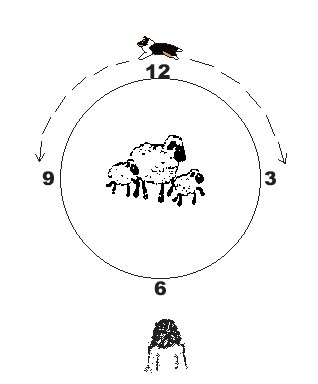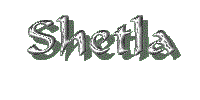 Breezy has turned the sheep and is fetching them to me.
Breezy has turned the sheep and is fetching them to me.
I am walking backwards.
Text by Nanna Holt Kjaer (September 2000)
Types of Herding Dogs
Herding dogs are divided into categories according to their working style. The
Shetland Sheepdog belongs to the loose-eyed group, i.e. they use their body and
movement to control and move the sheep. Whereas the sheepdog par excellence,
the Border Collie, is famous for its eye: its intense stare. Typically, the
Sheltie will therefore move further along each side of the flock in a
semi-circle.
This can be illustrated by using the face of a clock:
|

The sheep are in the centre of the clock, the handler/shepherd at 6 o'clock,
and the Sheltie moves between 9 and 3 o'clock.
In comparison, the Border Collie usually stays between 10 and 2 o'clock. The
"eye" saving it the waste of energy in the extra movement.
|
Pressure and Flight Zone
The sheep move away from the dog because the dog puts pressure on the them by
entering into their so-called flight zone. This is something that all
gregarious animals (i.e. animals that live in packs or herds) have, even
humans. Maud gave us an example: You and your group (family, friends or the
like) are having a picnic in a quiet place when you notice that a group of
strangers are approaching. You keep an eye on them and hope that they will stop
or go past, and if they get too close, you will want to pack up and move
somewhere else or at least feel uncomfortable.
Individual Point of Balance
Another important key to understanding what herding is, is the term "individual
point of balance". This is also something that all gregarious animals have, and
depending on where you put "pressure", the animal will move in a certain
direction. For sheep and dogs this point is situated at their shoulder. If you
are behind its shoulder, the sheep will go forward; if you get in front of its
shoulder, the sheep will turn around and go in the other direction. And if you
stand precisely level with the shoulder, the sheep should stand still.
In order to gain an understanding of this fenomenon, we got the job of herding
a small flock of ducks through a course of obstacles to go round - without the
help of our dogs, that is! The only help we had, was a herding staff that made
it easier to change our "pressure" on the ducks' point of balance.
Sometimes we humans even use this on each other. When guiding a group of people
through a narrow point of passage like a door, we often hold the door with one
hand and then as the first person's point of balance has passed us, we stretch
out our free hand in continuation of the door and maybe even make the passage
narrower. In actual fact, this is putting pressure on the point of balance to
make people go in faster.
Instinct Test
During the instinct test itself, Maud looked for the dog to try and stop the
sheep in their line of movement or flight, i.e. whether the dog went up to the
heads of the sheep to turn them round towards the handler.
Nearly all the participating Shelties showed at least a glimpse of instinct,
but not everyone had the self-confidence to make the sheep change direction.
Maud Grönberger
Maud Grönberger lives on a farm in the middle of a nature reservation in the
southern part of Skåne, a Swedish province. Here she holds classes in herding.
She has also written a book in Swedish about the behaviour of sheepdogs and how
to train them:
Herdeskolans ABC - Dansa med vallhundar
. Even with no interest in actual herding, this is a great book. Several of the
participants said that they got new insight into their Shelties' hitherto
puzzling behaviour.
You can see pictures and read more about Maud and her work on her home page:
www.algonet.se/~bc_herd
 Breezy going round the sheep in order to get up to their heads and turn them
Breezy going round the sheep in order to get up to their heads and turn them
The photos were taken at Breezy's second exposure to sheep, when she was 10
months old.
You can read a detailed account of Breezy's first year of herding in
"How I Got Hooked on Herding".
An article I originally wrote for the Sheltie Pacesetter in 2001.
|

